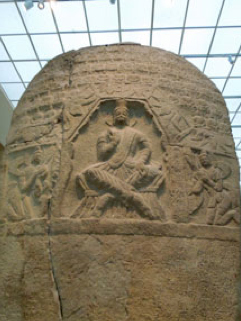In the great Buddhist grottos at Dunhuang, the unequalled repository of Buddhist statues and art in China’s far west, certain Buddha figures do not sit in full lotus as one might expect. Nor do they stand erect, another common posture. Instead, they sit with their legs crossed at their ankles, a puzzling, rather uncomfortable looking position. The Chinese scholar Gu Zhengmei argues that this posture is a sure sign that these statues represent Maitreya Buddha, the “Buddha to Come” who is said to appear in the world when all have forgotten the dharma. He claims that it is consistent with discoveries of Maitreya images not just at Dunhuang, but also in Greek-influenced Gandhara, where the first icons of the Buddha were found.

But why does Maitreya sit with his legs crossed at the ankles, instead of in full lotus? It may be because the kings who commissioned these buddha images intended them to represent the kings themselves. By claiming to be the very incarnation of Maitreya, kings could command ultimate religious status, and thus control the spiritual aspects of their subjects’ lives. By and large, kings enjoy diets that are not conducive to sitting in the lotus position—when kings who claim to be buddhas cross their legs, they’d prefer to do so at the ankles, not at the thighs! So the Maitreya statues depict kings sitting in a chair, their crossed ankles suggesting their holy status with only a half-hearted nimbleness.
Certain rulers can be connected with this phenomenon, all of them key links in the importation of political Buddhism into China. One was the emperor Kanishka of the mid-2nd century AD Kushan Empire, whose domain included much of present-day Afghanistan and Pakistan. The empire’s artistic culture was deeply imbued with Greek and Buddhist influence; statues of Kanishka depict him in this telltale crossed-ankles pose. Another was the first king to create Buddhist icons at Dunhuang, Meng Sun of the Northern Lian Dynasty, who is also portrayed in Dunhuang’s first caves as Maitreya, sitting with ankles crossed.
Kings using religion to help them reign and employing holy icons for their own aggrandizement are ploys as old as rulers and religion. Buddhism was as susceptible to this as any other teaching. Despite its original ideal of the “home leaver” who left the polluted world behind, the religion was quite thoroughly sucked into the vortex of politics in ancient China. These statues of Maitreya may be one slightly comical result.
—Andy Ferguson
This post is part of author and scholar Andy Ferguson’s new “Consider the Source” series. As an old Chinese saying goes, “When drinking water, consider the source.” In the coming weeks, Ferguson will ask and answer seemingly simple (but in the end, profound) questions about the “source” of East Asian Buddhism, weaving a tale of both spiritual inspiration and political intrigue.
This fall, Tricycle will be traveling to the source itself, China, in a special pilgrimage led by Ferguson and abbot of the Village Zendo Roshi Pat Enkyo O’Hara. Want to come with us? Click here for more information.